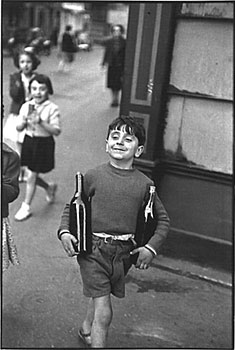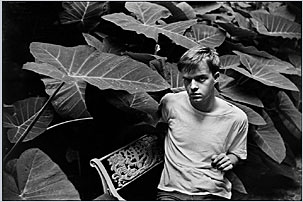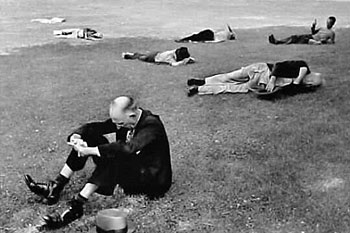| photography
This is a Henri Cartier-Bresson festival. I ran across this mention of a retrospective of his. He was always a favorite of mine and is the patron saint of all street photographers. Cartier-Bresson always used Leicas. At one time he must have used a IIIc just like the camera my Grandfather gave me.
Eternity in an Instant
Henri Cartier-Bresson spent half a century capturing some of the most iconic images of our time. Paris celebrates his work with a stunning retrospective and a new foundation
It doesn't interest me," Henri Cartier-Bresson says of photography. "It never has. The only thing that has ever been important is drawing." He is sitting at the living-room window of his fifth-floor Paris apartment, looking out over the Tuileries Gardens. It's almost exactly the same plunging view, he points out, that was painted by Monet and Cézanne. Cartier-Bresson abandoned photography in the mid-1970s and now prefers to discuss painting and drawing, his later passions. But even he can't deny the unforgettable images he captured during a half-century of photojournalism.
[more]
thanks to Esthet

Tête à Tête
Portraits by Henri Cartier-Bresson
When Henri Cartier-Bresson picked up his Leica in 1932, it was a miraculous new kind of camera, small and light, equipped with a sharp, fast lens and filled with a long roll of 35 mm film. This remains the kind of camera most of us know and use today, but before that time virtually all cameras were larger and more cumbersome. The amateur's Kodak, although easy to use, offered little control over composition, and the press photographer's Speed Graphic used large sheets of film that had to be loaded one at a time and often needed a bulky flash. Of course, ambitious photographers devised clever ways to get around their clumsy materials, choosing subjects that didn't move too much, counting on luck and quick reflexes to freeze motion, or perfecting the image in the darkroom, where it was easy to crop out awkward information and improve the composition.
Henri Cartier-Bresson was an aspiring painter and student of literature when he first saw Martin Munkacsi's brilliant photographs of runners, swimmers, and race-car drivers, which appeared in the new illustrated magazines being published in Germany and France. Through Munkacsi's work, Cartier-Bresson recognized how the new small cameras made it possible to capture spontaneous motion while creating beautiful compositions within the rectangular shape of a single frame of 35 mm film. He was also deeply influenced by the contemporary movement known as surrealism, which encouraged artists and writers to explore the meaning that lay hidden below the surface of everyday life. In the hands of the surrealists, photography became a way to reveal significance that would otherwise be invisible or lost. When captured in a photograph, a simple gesture, chance meeting, or mundane setting could convey great beauty or tragedy or humor.

Truman Capote, 1947
[more]
HENRI CARTIER - BRESSON
Henri Cartier-Bresson
(1908 - ?)
"In photography, the smallest thing can be a great subject," he wrote in ‘The Decisive Moment’. "The little human detail can become a leitmotif." Most of his photography is a collection of such little, human details; concerned images with universal meaning and suggestion. He lived in a haunted world where mundane facts, a reflection in a mud-puddle, an image chalked on a wall, the slant of a black-robed figure against mist, radiate significance at once familiar and only half-consciously grasped. His was an anti-romantic poetry of vision, which finds beauty in "things as they are," in the reality of here and now.
All his great pictures were taken with the kind of equipment owned by many amateur photographers: 35 mm rangefinder cameras equipped with a normal 5Omm lens or occasionally a telephoto for landscapes.
Along with Dr. Erich Salomon and Alfred Eisenstaedt, he was a pioneer in available light photojournalism, and would no sooner intrude flash or flood into his pictures than would a fly fisherman toss rocks into a pool where he hoped to catch a prize trout.
By having so skillfully exploited the camera’s ability to transfix a moment in time’s flow, Cartier-Bresson has left us a treasure of images. We can, through his eyes, see the world a little more clearly, and find truth and beauty where we had not guessed they existed.

[more]
Henri Cartier-Bresson
Henri Cartier-Bresson: From a higher reality to a respect for reality
Henri Cartier-Bresson Foundation
Henri Cartier-Bresson
Known for its reportage style and early connection to the rebelliousness of Surrealism, the work of Cartier-Bresson has always subverted narrative expectations. A reluctant and ambivalent scion of the bourgeoisie, Cartier-Bresson captured in photographs the plight of the very dispossessed, marginal, and illicit underclass shunned by his own socio-economic community. His venues ranged from Mexican flea markets and African street fairs to the Jewish ghettoes of Eastern Europe.
A sense of the photographer's visceral engagement with his subjects emerges from the natural, unposed moments he chooses to present them in. This technique, which he termed "incomplete adventures" or "happenings in the moment," originated with Cartier-Bresson and laid the foundation for the approach known as "the decisive moment," a style that transformed photojournalism to a high art. "The decisive moment" occurs in flashes during the everyday pursuits of work, play, and contemplation, and reveals an open sensuality which is not normally the prerogative of the outcast.
[more]
Henri Cartier-Bresson
Henri Cartier-Bresson
Henri Cartier-Bresson |

